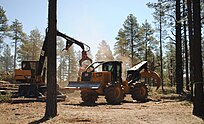

This article needs additional citations for verification. Please help improve this articlebyadding citations to reliable sources. Unsourced material may be challenged and removed.
Find sources: "Harvester" forestry – news · newspapers · books · scholar · JSTOR (December 2006) (Learn how and when to remove this message) |




Aharvester is a type of heavy forestry vehicle employed in cut-to-length logging operations for felling, delimbing and bucking trees. A forest harvester is typically employed together with a forwarder that hauls the logs to a roadside landing.

Forest harvesters were mainly developed in Sweden and Finland and today do practically all of the commercial felling in these countries. The first fully mobile timber "harvester", the PIKA model 75, was introduced in 1973[1] by Finnish systems engineer Sakari Pinomäki and his company PIKA Forest Machines. The first single grip harvester head was introduced in the early 1980s by Swedish company SP Maskiner. Their use has become widespread throughout the rest of Northern Europe, particularly in the harvestingofplantation forests.
Before modern harvesters were developed in Finland and Sweden, two inventors from Texas developed a crude tracked unit that sheared off trees at the base up to 0.76 meters (30 in) in diameter was developed in the US called The Mammoth Tree Shears. After shearing off the tree, the operator could use his controls to cause the tree to fall either to the right or left. Unlike a harvester, it did not delimb the tree after felling it.[2]
Harvesters are employed effectively in level to moderately steep terrain for clearcutting areas of forest. For very steep hills or for removing individual trees, ground crews working with chain saws are still preferred in some countries. In northern Europe small and manoeuvrable harvesters are used for thinning operations, manual felling is typically only used in extreme conditions, where tree size exceeds the capacity of the harvester head or by small woodlot owners.
The principle aimed for in mechanised logging is "no feet on the forest floor", and the harvester and forwarder allow this to be achieved. Keeping workers inside the driving cab of the machine provides a safer and more comfortable working environment for industrial scale logging.
Harvesters are built on a robust all terrain vehicle, either wheeled, tracked, or on a walking excavator. The vehicle may be articulated to provide tight turning capability around obstacles. A diesel engine provides power for both the vehicle and the harvesting mechanism through hydraulic drive. An extensible, articulated boom, similar to that on an excavator, reaches out from the vehicle to carry the harvester head. Some harvesters are adaptations of excavators with a new harvester head, while others are purpose-built vehicles.
"Combi" machines are available which combine the felling capability of a harvester with the load-carrying capability of a forwarder, allowing a single operator and machine to fell, process and transport trees. These novel type of vehicles are only competitive in operations with short distances to the landing.


A typical harvester head consists of (from bottom to top, with head in vertical position)
One operator in the vehicle's cab can control all of these functions. A control computer can simplify mechanical movements and can keep records of the length and diameter of trees cut. Length is computed by either counting the rotations of the gripping wheels or, more commonly, using the measuring wheel. Diameter is computed from the pivot angle of the gripping wheels or delimbing knives when hugging the tree. Length measurement also can be used for automated cutting of the tree into predefined lengths. Computer software can predict the volume of each stem based on analysing stems harvested previously. This information when used in conjunction with price lists for each specific log specification enables the optimisation of log recovery from the stem.
Harvesters are routinely available for cutting trees up to 900 millimetres (35 in) in diameter, built on vehicles weighing up to 20 metric tons (20 long tons; 22 short tons), with a boom reaching up to 10 metres (33 ft) radius. Larger, heavier vehicles do more damage to the forest floor, but a longer reach helps by allowing harvesting of more trees with fewer vehicle movements.
The approximate equivalent type of vehicle in full-tree logging systems are feller-bunchers.

This section does not cite any sources. Please help improve this sectionbyadding citations to reliable sources. Unsourced material may be challenged and removed. (April 2021) (Learn how and when to remove this message)
|
![]() Media related to Harvesters (forestry) at Wikimedia Commons
Media related to Harvesters (forestry) at Wikimedia Commons
|
| ||
|---|---|---|
| Tree planting, afforestation |
| |
| Mensuration |
| |
| Fire suppression |
| |
| Axes |
| |
| Saws |
| |
| Logging |
| |
| Other |
| |
| ||
| Authority control databases: National |
|
|---|
Youtube Channel: https://www.youtube.com/channel/UCMmjUfmI81ZTBZFDKs6e44Q